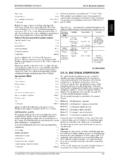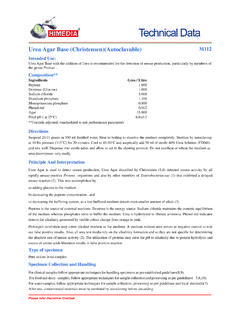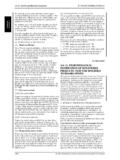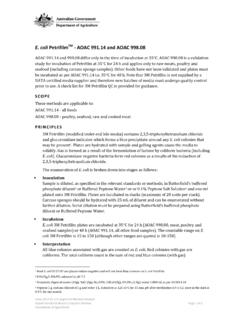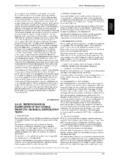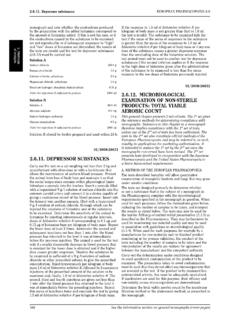Transcription of Annex 5 Multiple-tube method for thermotolerant …
1 Annex 5189 Annex 5 Multiple-tube method forthermotolerant (faecal) coliformsIn the Multiple-tube method , a series of tubes containing a suitable selective brothculture medium is inoculated with test portions of a water sample. After aspecified incubation time at a given temperature, each tube showing gas forma-tion is regarded as presumptive positive since the gas indicates the possiblepresence of coliforms. However, gas may also be produced by other organisms,and so a subsequent confirmatory test is essential. The two tests are knownrespectively as the presumptive test and the confirmatory the confirmatory test, a more selective culture medium is inoculated withmaterial taken from the positive tubes . After an appropriate incubation time, thetubes are examined for gas formation as before. The most probable number (MPN)of bacteria present can then be estimated from the number of tubes inoculatedand the number of positive tubes obtained in the confirmatory test, using spe-cially devised statistical tables.
2 This technique is known as the MPN InoculationDifferent test portions to provide tenfold serial dilution steps may be used, thedilutions being based on the anticipated number of coliform bacteria in the watersample being tested. The reliability of the result obtained depends on the numberof tubes inoculated with each test portion; in certain instances, the number canbe reduced to three in each dilution step. Each combination of inoculated tubeswill have its own table of MPN values. Typical volumes for analysis are given inTable (p. 62). Unpolluted and treated waterWater in or entering the distribution system may generally be assumed to containlittle or no pollution. In this case, it is recommended that one 50-ml plus five 10-ml volumes of water sample should be inoculated into the tubes ; five tubes shouldeach contain 10 ml and one tube 50 ml of double-strength Polluted waterWater suspected to be more highly contaminated, untreated water fromcertain raw water sources, should be examined using different inoculation vol-umes in tenfold dilution steps.
3 The following inoculations are normally made:GUIDELINES FOR DRINKING-WATER QUALITY190 10 ml of sample to each of five tubes containing 10 ml of double-strengthmedium; ml of sample to each of five tubes containing 10 ml of single-strengthmedium; ml of a 1 : 10 dilution of sample ( ml of sample) to each of fivetubes containing 10 ml of single-strength the sample is expected to be highly contaminated, aliquots of ml oftenfold serial dilutions from each dilution step are inoculated into five tubes thateach contain 10 ml of single-strength the workload is very heavy and the time available is limited, the number oftubes can be reduced to three in each series. Statistically, however, inoculation offive tubes with each sample volume produces a more reliable MPN Equipment and suppliesThe following laboratory equipment and glassware are essential: Autoclave: required for sterilizing the culture media. Its size should be deter-mined by the number and type of samples to be taken.
4 Operation of theautoclave should be strictly in accordance with the manufacturer s instruc-tions and should ensure that all the air in the chamber is replaced by should be achieved in not more than 30 minutes. Strict ad-herence to recommended sterilization temperatures and times for differenttypes of culture media is essential. Racks are needed to hold tubes and bottlesof prepared culture media in the autoclave. Incubator(s) or water-baths: must each be fitted with a temperature controland should be capable of maintaining a uniform temperature correct to 35 or37 6 C and/or 44 or 6 C. The choice of temperaturedepends on the indicator bacteria and the medium used. The temperature ofincubators and water-baths fitted with thermometers placed at representativepoints should be monitored periodically (preferably daily). Stainless-steelracks should be fitted to hold sample tubes . Balance: needed for weighing powdered culture medium.
5 It should have anaccuracy of g. A weighing scoop is also required. (No balance is requiredif culture media are available in suitable preweighed quantities.) Water distillation apparatus, hose, and container: required to produce non-toxic water, water free from any substances that can interfere withbacterial growth. The container for the distilled water should have a volumeof at least 5 litres and be fitted with a tap. Pipettes: 1 ml and 10 ml, with cotton plugs at the mouthpiece, are 1-ml pipettes should be graduated in increments and are used forpreparing dilutions; the 10-ml pipettes are used for the addition of samplesto tubes containing media. Any pipettes with chipped or broken tips shouldANNEX 5191be discarded. Glass pipettes can be conveniently stored in a sterilizable metalcontainer; alternatively, disposable plastic pipettes can be used. A separatecontainer should be employed for each size of pipette.
6 Pipettes may also bewrapped individually in paper and heat-sterilized. Pipette canisters and bulbsare also needed, as is a container for discarded pipettes. Test- tubes and racks: tubes can be 20 3 150 mm in size for 10-ml samplevolumes plus 10 ml of culture medium (screw caps are not recommended forfermentation media). The racks should be large enough to accommodateculture tubes of the largest diameter used. Bottles: used for the larger volumes consisting of 50 ml of sample and 50 mlof culture medium. They should have loose-fitting caps and ideally be cali-brated with 50-ml and 100-ml marks. Media preparation equipment: glass or stainless-steel containers (usuallyflasks) are required. Any heating equipment and stirrers used in the prepara-tion of media should be clean and free from soluble toxic materials. Gas burner: a Bunsen or similar burner is adequate. Culture tubes containing inverted vials (Durham tubes ): each tube should belarge enough for a vial, completely filled with medium, to be submerged in it.
7 Inoculation loop and holder: lengths of 24- or 26-gauge wire ( 10 cm)should be used. Nichrome wire is acceptable, but platinum iridium is wire is set in a handle made of metal or glass, of diameter similar to thatof a pencil. To make the inoculation loop, the wire is bent to form a circle 3 4 mm in diameter. Dispenser: for sodium thiosulfate solution (see below). Cleaning and maintenance equipment: items such as brushes for cleaningtubes, bottles, etc., a waste bin, and a tool kit are required. Safety equipment: there should be an adequate first-aid kit and a fire extin-guisher or other means of fire control in every laboratory. General laboratory equipment: various sizes of round and Erlenmeyer flask,beakers, stands, glass or unbreakable plastic measuring flasks, spatulas, following equipment is also desirable in a laboratory: Refrigerator: for the storage of prepared culture media. Hot air sterilizer: for sterilizing following consumable items are required: Culture medium: Table describes the uses for the various media; see alsosection Laboratory disinfectan t: for cleaning laboratory surfaces and the pipette dis-card bin.
8 Detergent: for washing glassware, etc. Sodium thiosulfate solution: required when chlorinated supplies are FOR DRINKING-WATER QUALITY192 Table Culture media for MPNaMediumUsesIncubatorRemarkstemperatur eMacConkeyPresumptive isolation 35 6 C orTraditional medium for thebrothof coliform bacteria37 6 Cpresumptive isolation of coliformbacteria by MPN. The quality ofbile salts can vary and mayaffect the resultLauryl tryptosePresumptive35 6 C or (lactose) brothisolation of37 6 Ccoliform bacteriaConfirmation of44 C thermotolerantcoliform bacteriaImprovedPresumptive35 6 C orThis is a selective mediumformateisolation of37 6 Cbecause it contains chemicallylactosecoliform bacteriadefined nutrients that can beglutamateutilized only by a limitedmediumnumber of bacterial composition of themedium is complex and specialcare is required duringpreparationBrilliant greenConfirmation of35 6 C orMedia for gas productionlactose (bile)coliform bacteria37 6 Cbroth;Confirmation of44 CECthermotolerantcoliform bacteriaTryptone waterProduction of indole44 CThe formation of indole,for confirmation ofdetected by the addition ofEscherichia coliKovacs reagentb to tryptonewater after incubation, withgas production from lactose at44 C indicates the presence ofE.
9 ColiaAdapted from ISO 9308-2: 1990. Detection and enumeration of coliform organisms, thermotolerantcoliform organisms, and presumptive Escherichia coli Part 2: multiple tube (most probable number) make Kovacs reagent, dissolve 5 g p-dimethylaminobenzaldehyde in 75 ml amyl (or isoamyl)alcohol, and add 25 ml concentrated hydrochloric acid slowly. Store at 4 C in the thiosulfate neutralizes any residual chlorine in samples at the time ofcollection, preventing it from acting on any microorganisms present in watersamples. Autoclave tape. Diluent: typical diluents include Ringer s solution and Culture media and dilution waterCommercially available dehydrated media simplify the preparation of culturebroths and are therefore recommended for laboratory work. Various manufactur-ers produce these media as powders, which can then be easily weighed out,dissolved in distilled water, and dispensed into culture tubes before Preparation of mediaMedia should be prepared in accordance with the manufacturer s instructions, asfollows:(a) Dissolve the stated amount of the dehydrated medium in distilled water toobtain the double-strength or single-strength presumptive medium (for con-firmatory analysis, only single-strength medium is used).
10 (b) Dispense the requisite volume into culture tubes containing an invertedDurham tube, and cap the culture tubes .(c) Sterilize in an autoclave or pressure cooker at 115 C for 10 minutes (or inaccordance with the manufacturer s specifications). It is particularly impor-tant that media containing disaccharides, lactose, are not autoclaved athigher temperatures.(d) The sterilized medium may be stored at room temperature (approximately25 C) or, ideally, at 2 8 C. Media should in any case be warmed to roomtemperature before use to ensure that all components have redissolved. Inaddition, since several dyes are light-sensitive, the solution should be pro-tected from exposure to Preparation of dilution waterA special buffered, sterilized water is used to make sample dilutions for inocula-tion into the culture medium. It is prepared from a concentrated stock solutionof phosphate buffer. To make the stock solution, dissolve 34 g of potassiumdihydrogen phosphate (KH2PO4) in 500 ml of distilled water.











